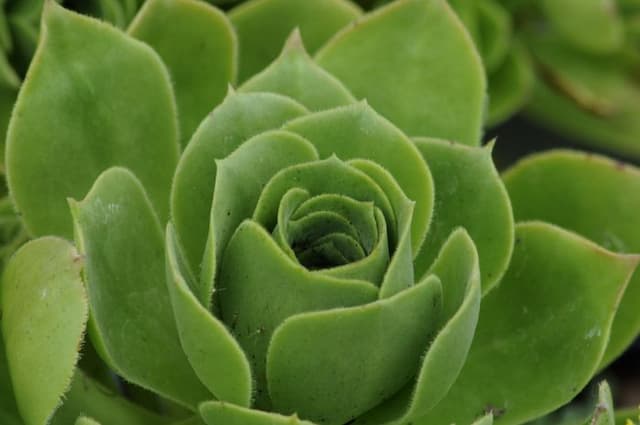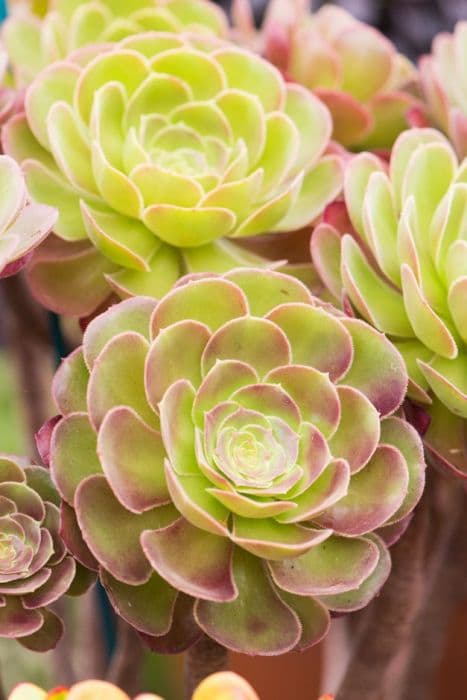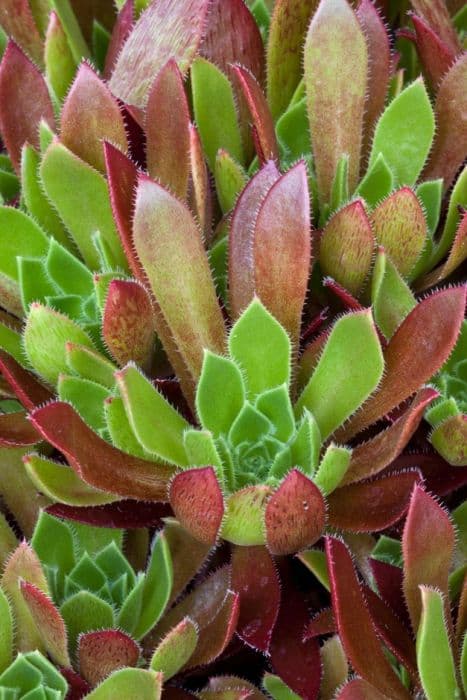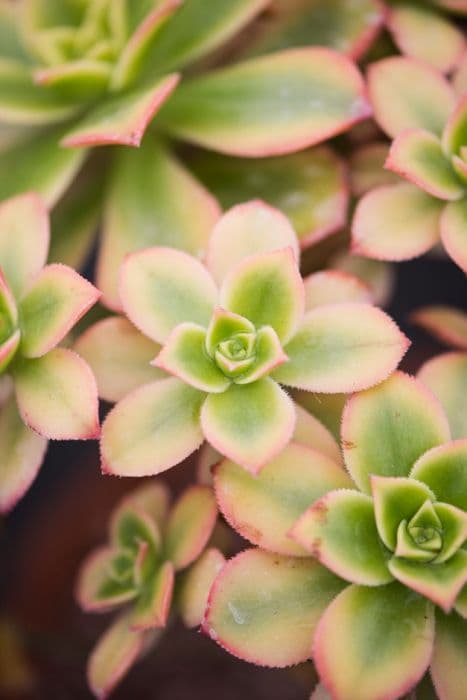Hen and Chicks Sempervivum 'Green Dragon'

ABOUT
The 'Green Dragon' is a captivating succulent that boasts rosettes reminiscent of lush green, spiky dragons' scales. With leaves that can range from a deep, rich green to having reddish tips, the overall visual effect is one that is vibrant and eye-catching. Each rosette comprises tightly packed, fleshy leaves that are pointed at the tips, seemingly protecting the plant's core. The texture and form of the plant create a dramatic, sculptural quality. This plant often forms dense clusters, as the main rosette, also known as the mother plant, produces numerous offsets or pups that surround it, creating a carpet of greenery with a somewhat otherworldly appearance. The 'Green Dragon' is admired for this striking growth habit and its ability to add a touch of exotic allure to any plant collection or garden composition.
About this plant
 Names
NamesFamily
Crassulaceae
Synonyms
Hens and Chicks, Houseleeks, Live Forever
Common names
Sempervivum 'Green Dragon'.
 Toxicity
ToxicityTo humans
The houseleek is generally considered safe and non-toxic to humans. There are no common symptoms of poisoning reported for humans because it is not known to be poisonous if ingested. However, it's always prudent to avoid consuming any plant matter unless it's known to be edible, as individual reactions can vary.
To pets
The houseleek is also considered non-toxic to pets. It is not known to cause poisoning in animals, and there are no common symptoms of poisoning from ingestion. As with humans, it is generally safe, but monitoring pets and preventing them from eating plants is always a cautious practice.
 Characteristics
CharacteristicsLife cycle
Perennials
Foliage type
Evergreen
Color of leaves
Green
Flower color
Pink
Height
0.5 feet (15 cm)
Spread
1 foot (30 cm)
Plant type
Succulent
Hardiness zones
3
Native area
Europe
Benefits
 General Benefits
General Benefits- Easy to Care For: Sempervivum 'Green Dragon', commonly known as hens and chicks, is highly resilient and can thrive with minimal maintenance.
- Drought Tolerant: This succulent is well adapted to dry conditions and requires infrequent watering, making it ideal for water-conservative gardens.
- Cold Hardy: Hens and chicks can withstand cold temperatures and frost, making it a great choice for outdoor gardens in various climates.
- Propagation: The plant easily propagates from offsets, allowing gardeners to expand their collection or share with others.
- Year-Round Interest: With its rosette shape and persistent foliage, hens and chicks provide visual interest throughout all seasons.
- Pest Resistant: The succulent nature of the plant makes it less appealing to many common garden pests.
- Versatility in Landscaping: It can be used in rock gardens, containers, ground cover, and green roofs, providing flexibility in garden design.
- Attracts Pollinators: During its bloom time, the flowers can attract bees and other beneficial pollinators to the garden.
- Reduces Soil Erosion: The mat-forming characteristic of hens and chicks helps stabilize soil and prevent erosion on slopes or in rock gardens.
 Medical Properties
Medical PropertiesThis plant is not used for medical purposes.
 Air-purifying Qualities
Air-purifying QualitiesThis plant is not specifically known for air purifying qualities.
 Other Uses
Other Uses- Luck and Superstition: Some people believe that Sempervivum, commonly known as houseleeks, bring good luck and protection when planted on roofs or at the entrance of homes.
- Model Landscaping: Hobbyists can use houseleeks in miniature landscaping projects such as model train displays or fairy gardens due to their small size and varied shapes.
- Rustic Wedding Decor: Houseleeks can be incorporated into rural or rustic wedding themes, serving as unique, sustainable boutonnieres or table centerpieces.
- Textile Dyeing: The pigments found in the leaves of houseleeks may be used to naturally dye textiles in shades of green or yellow, depending on the mordant used.
- Living Roofing Material: Beyond their traditional use, houseleeks can be planted as part of living roofs for modern eco-friendly architecture, aiding in insulation and biodiversity.
- Educational Tool: Educators may use houseleeks to teach children about plant growth, succulent care, and water conservation in a classroom setting.
- Photography Subject: Due to their geometric patterns and lush colors, houseleeks can be a captivating subject for botanical photographers and art projects.
- Mosaic Art: The rosette shapes and varying colors of houseleeks can be arranged to create natural mosaics in the garden or creative indoor displays.
- Culinary Decoration: Although not commonly eaten, houseleeks can be used as an inedible garnish to add a touch of greenery to dishes because of their ornamental appearance.
- Thermal Mass for Passive Heating: In permaculture design, the water stored in the leaves of houseleeks can be used to absorb and slowly release heat, contributing to passive heating in greenhouses.
Interesting Facts
 Feng Shui
Feng ShuiThe houseleek is not used in Feng Shui practice.
 Zodiac Sign Compitability
Zodiac Sign CompitabilityThe houseleek is not used in astrology practice.
 Plant Symbolism
Plant Symbolism- Endurance and Resilience: Commonly known as Hen and Chicks, Sempervivum 'Green Dragon' symbolizes the ability to withstand tough conditions and to thrive despite challenges due to its nature of surviving in rocky and arid environments.
- Eternal Life: Hen and Chicks represents immortality or the concept of life ever-renewing because of its prolific reproduction, creating offsets or 'chicks' that ensure the longevity of the colony.
- Protection: Historically, people believed that Hen and Chicks had the power to ward off lightning strikes when planted on rooftops, hence symbolizing protection and safety.
- Maternal Love: The name "Hen and Chicks" itself reflects motherly care, with the 'Hen' being the original rosette, and the 'Chicks' being the offspring that cluster around her.
 Water
WaterHen and chicks, commonly referred to as Sempervivum 'Green Dragon', require infrequent watering to thrive. As a succulent, it prefers the soak and dry method, meaning the soil should be allowed to dry out completely between waterings. Typically, watering once every 7 to 10 days during the active growing season in spring and summer is adequate. Reduce watering in the fall and winter to once a month or less, depending on humidity levels. When watering, provide enough water to thoroughly soak the soil, which may equate to around half a gallon for a medium-sized pot, though this can vary depending on pot size and environmental conditions.
 Light
LightHen and chicks do best in full sun to partial shade, making an outdoor spot that receives direct sunlight for at least six hours per day ideal. They can tolerate some shade, especially in hot climates, but too little light can lead to leggy growth and reduced color vibrancy. A south-facing window or a spot in a rock garden with plenty of sunlight is optimal for maintaining the bold colors and compact form of Sempervivum 'Green Dragon'.
 Temperature
TemperatureHen and chicks are hardy plants, with the Sempervivum 'Green Dragon' variety tolerating a temperature range from around -30°F to 80°F. They thrive in temperatures between 65°F and 75°F, which are typical during the spring and autumn months. This succulent is well-suited to withstand cold winters and hot summers as long as the extremes of their tolerance range are not surpassed.
 Pruning
PruningPruning hen and chicks like the 'Green Dragon' variety is mostly about removing dead or damaged leaves to maintain its appearance. This can be done as needed throughout the year. The best time to prune is in the early spring or after the plant blooms and the flowering stalk dies. Remove spent flower stalks and dead rosettes to encourage healthy growth. Pruning is not done for shaping as the plant naturally maintains its compact shape, but rather for the health and cleanliness of the plant.
 Cleaning
CleaningAs needed
 Soil
SoilThe best soil mix for Hens and Chicks (Sempervivum 'Green Dragon') is a well-draining mixture such as a cactus potting soil mixed with coarse sand or perlite. The soil pH should be slightly acidic to neutral, ranging from 6.0 to 7.5.
 Repotting
RepottingHens and Chicks should be repotted every 2-3 years to refresh the soil and provide room for growth. Spring or early summer is the best time to repot this succulent.
 Humidity & Misting
Humidity & MistingHens and Chicks prefer a dry climate and do well in low humidity environments typical of most households, as excessive humidity can lead to rotting.
 Suitable locations
Suitable locationsIndoor
Place in bright, indirect light and well-draining soil.
Outdoor
Full sun to partial shade, in soil with good drainage.
Hardiness zone
3-9 USDA
 Life cycle
Life cycleThe life of Sempervivum 'Green Dragon', commonly known as Hen and Chicks, begins with seed germination, where the tiny seeds sprout in well-draining soil with adequate warmth and light. After germination, the seedlings grow into rosettes, which are the primary photosynthetic organs of the plant, and these rosettes gradually increase in size and produce offsets. These offsets, or "chicks," grow at the base of the "hen" (the main rosette) and can eventually root and establish themselves as independent plants if they are provided with suitable conditions. As the plant matures, it goes through a vegetative stage, where it stores energy and increases in size while remaining predominantly a ground-cover plant. Following a few years of growth, the plant reaches its reproductive stage, where it sends up a flower stalk, blooms with star-shaped flowers, and then, being monocarpic, the flowering rosette dies after setting seed. The lifecycle is completed as the seeds disperse and find new locations to germinate, or as the remaining "chicks" take over and continue to propagate the colony.
 Propogation
PropogationPropogation time
Spring-Summer
The Sempervivum 'Green Dragon', commonly known as Hen and Chicks, is best propagated during the spring and summer months when the plant is actively growing. The most popular method of propagation for this succulent is through offshoots, also known as "chicks". These chicks grow at the base of the mother plant, known as the "hen", and can be gently pulled away when they have formed their own roots. It's important to allow the chicks to dry for a day or so to callous over the wound to prevent rotting before planting them in well-draining soil. With proper care, these chicks will readily establish themselves and grow into new, independent plants, perpetuating the cycle of the Green Dragon.









